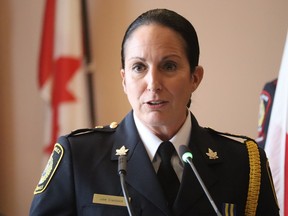Officers from Sarnia and other communities received training recently to help better respond to calls about intimate partner violence.

Officers from Sarnia and other communities received training recently to help better respond to calls about intimate partner violence.
Advertisement 2
Article content
“One of the first things I did when I came to the police service, I met with a lot of the local community agencies, and some of the feedback I received was that the police response was very professional, but in certain circumstances it was missing kind of the empathy when dealing with victims who have experienced these types of offenses,” said Sarnia police deputy chief Julie Craddock.
Article content
With domestic disturbance calls in Sarnia on the rise — 1,472 in 2023, up 12 per cent from 2022 — and partner intimate violence recently declared an epidemic by Lambton County council, addressing that is important, she said.
“It’s different than other types of offenses,” Craddock said about intimate partner violence.
“There is a greater psychological impact on people who are experiencing IPV because of the real loss of safety and security. Often these are offenses that are happening within people’s homes.”
Advertisement 3
Article content
Fifty-six Sarnia officers, including front-line supervisors, officers, and members of the mental health engagement response team (MHEART), and the service’s integrated mobile police and community team (IMPACT) recently received training from the local Sexual Assault Survivors’ Center on trauma-informed responses, Craddock said.
The service also doubled, to four, the number of officers in its criminal investigations unit with domestic violence investigation training, to investigate complex incidents where multiple charges may be involved, she said.
And it held B-Safer training for 10 Sarnia officers, four Chatham-Kent officers, two from Strathroy-Caradoc and two from St. Thomas.
Survivors’ center and Victim Services of Sarnia-Lambton personnel also attended the training focused on risk assessment, she said.
Advertisement 4
Article content
“Because we want to make sure the people who come forward to report are safe afterwards.”
Sarnia wasn’t doing a lot in the area of risk assessment before, she said.
Including other services is helpful because “small and mid-sized services are also struggling with budgets and fundings to have a better service delivery model, better outcomes for victims,” she said.
Sarnia received a $99,000 provincial government victim support grant for the training that required partnering with other location organizations, including the survivors’ center and victim services, she said.
More training also is planned with the money, which has to be spent by the end of March, she said — for eight officers, two per platoon — building on the earlier training sessions.
Advertisement 5
Article content
The idea is to have those officers be the first to respond to intimate partner violence calls, when they’re available, she said.
“To really make sure that that initial contact with police is as positive as we can make it.”
Inspired by the collaborative nature of the grant, police also have been giving real-time statistics about domestic violence calls to a Victim Services official, so the agency can respond faster.
That’s worked well, Craddock said.
The Victim Services official was paid by police using the grant money — they still remained a Victim Services employee — and given access to a police computer with those real-time stats after taking oaths of secrecy, Craddock said.
Previously police would email the relevant data, but that would take longer, and some things could conceivably be missed or omitted, she said.
When the grant money ends, the victim service official’s salary will no longer be paid by police, but hopes are to draft a memorandum of understanding to continue real-time data sharing, she said
“Because it is of benefit to them and it’s of benefit to the victims.”
When that new agreement will be inked isn’t clear, she said.
Article content